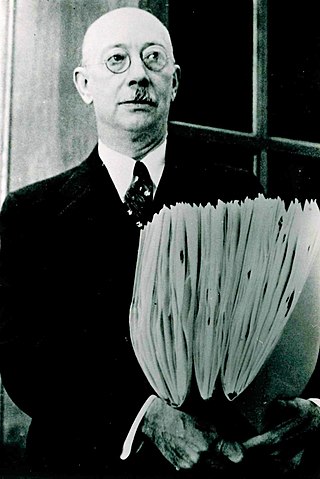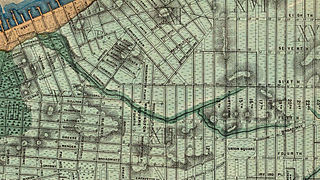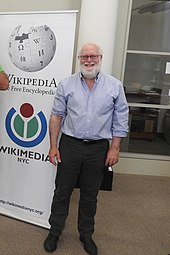
Inwood Hill Park is a 196 acres (79 ha) public park in the Inwood neighborhood of Manhattan, New York City, operated by the New York City Department of Parks and Recreation. On a high schist ridge that rises 200 feet (61 m) above the Hudson River from Dyckman Street to the northern tip of the island, Inwood Hill Park's densely folded, glacially scoured topography contains the largest remaining old-growth forest on the island of Manhattan. The area is also known as the Shorakapkok Preserve, shorakapkok meaning 'the sitting place' in the Munsee language used by the Wecquaesgeek tribe who inhabited the area for nearly 700 years. Unlike other Manhattan parks, Inwood Hill Park is largely natural and consists of mostly wooded, non-landscaped hills.

Todt Hill is a 401-foot-tall (122 m) hill formed of serpentine rock on Staten Island, New York. It is the highest natural point in the five boroughs of New York City and the highest elevation on the entire Atlantic coastal plain from Florida to Cape Cod. The summit of the ridge is largely covered in woodlands as part of the Staten Island Greenbelt, although much of the surrounding area is developed and residential. It is considered one of the most exclusive and most expensive areas of Staten Island.

Husky Energy Inc. was a Canadian company engaged in hydrocarbon exploration, headquartered in Calgary, Alberta, Canada. It operates in Western and Atlantic Canada, the United States and the Asia Pacific region, with upstream and downstream business segments. In the 2020 Forbes Global 2000, Husky Energy was ranked as the 1443rd-largest public company in the world.

Bronx Park is a public park along the Bronx River, in the Bronx, New York City. The park is bounded by Southern Boulevard to the southwest, Webster Avenue to the northwest, Gun Hill Road to the north, Bronx Park East to the east, and East 180th Street to the south. With an area of 718 acres (2.91 km2), Bronx Park is the eighth-largest park in New York City.

The Wildlife Conservation Society (WCS) is a 501(c)(3) non-governmental organization headquartered at the Bronx Zoo in New York City, that aims to conserve the world's largest wild places in 14 priority regions. Founded in 1895 as the New York Zoological Society (NYZS), the organization is now led by President and CEO, Monica P. Medina, who replaced long time President and CEO Cristián Samper in 2023. WCS manages four New York City wildlife parks in addition to the Bronx Zoo: the Central Park Zoo, New York Aquarium, Prospect Park Zoo and Queens Zoo. Together these parks receive 4 million visitors per year. All of the New York City facilities are accredited by the Association of Zoos and Aquariums (AZA).

The Chicago Botanic Garden is a 385-acre (156 ha) living plant museum situated on nine islands in the Cook County Forest Preserves. It features 27 display gardens and five natural habitats including Mary Mix McDonald Woods, Barbara Brown Nature Reserve, Dixon Prairie, the Skokie River Corridor, and the Lakes and Shorelines. The garden is open every day of the year. An admission fee has been approved to start in 2022, not to exceed $35.

Henry Allan Gleason (1882–1975) was an American ecologist, botanist, and taxonomist. He was known for his endorsement of the individualistic or open community concept of ecological succession, and his opposition to Frederic Clements's concept of the climax state of an ecosystem. His ideas were largely dismissed during his working life, leading him to move into plant taxonomy, but found favour late in the twentieth century.

Carl Safina is an American ecologist and author of books and other writings about the human relationship with the natural world. His books include Becoming Wild: How Animal Cultures Raise Families, Create Beauty, and Achieve Peace; Beyond Words: What Animals Think and Feel; Song for the Blue Ocean; Eye of the Albatross; The View From Lazy Point: A Natural Year in an Unnatural World; and others. He is the founding president of the Safina Center, and is inaugural holder of the Carl Safina Endowed Chair for Nature and Humanity at Stony Brook University. Safina hosted the PBS series Saving the Ocean with Carl Safina.

Michael David Sorkin was an American architectural and urban critic, designer, and educator. He was considered to be "one of architecture's most outspoken public intellectuals", a polemical voice in contemporary culture and the design of urban places at the turn of the twenty-first century. Sorkin first rose to prominence as an architectural critic for the Village Voice in New York City, a post which he held for a decade throughout the 1980s. In the ensuing years, he taught at prominent universities around the world, practiced through his eponymous firm, established a nonprofit book press, and directed the urban design program at the City College of New York. He died at age 71 from complications brought on by COVID-19 during the COVID-19 pandemic.

Marcus Garvey Park is a 20.16-acre (81,600 m2) park on the border between the Harlem and East Harlem neighborhoods of Manhattan, New York City. The park, centered on a massive and steep outcropping of schist, interrupts the flow of Fifth Avenue traffic, which is routed around the park via Mount Morris Park West. The park is also bounded by 120th Street to the south, 124th Street to the north, and Madison Avenue to the east.
Mount Morris Park Historic District is a 16-block historic district in west central Harlem, Manhattan, New York City. It was designated by the New York City Landmarks Preservation Commission in 1971, and is part of the larger Mount Morris Park neighborhood. The boundaries are West 118th and West 124th Streets, Fifth Avenue, and Adam Clayton Powell Jr. Boulevard.

Conservatory Water is a pond located in a natural hollow within Central Park in Manhattan, New York City. It is located west of Fifth Avenue, centered opposite East 74th Street. The pond is surrounded by several landscaped hills, including Pilgrim Hill dotted by groves of Yoshino cherry trees and Pug Hill, resulting in a somewhat manicured park landscape, planned in deferential reference to the estate plantings of the owners of the mansions that once lined the adjacent stretch of Fifth Avenue.
The Earth Institute Center for Environmental Sustainability, formerly known as the Center for Environmental Research and Conservation (CERC), consists of two institutions located at Columbia University. The first is an Earth Institute which started as the first Earth Institute in 1995. The second is the Secretariat of the Consortium for Environmental Research and Conservation, established in cooperation with The Earth Institute, the American Museum of Natural History, the New York Botanical Garden, the Wildlife Conservation Society and EcoHealth Alliance on biodiversity conservation.
The Mannahatta Project is a Wildlife Conservation Society research project in historical ecology led by landscape ecologist Eric W. Sanderson that principally ran for 10 years from 1999-2009, reconstructing the island at the point of first contact between the Dutch ship Halve Maen and the Lenape in 1609. The work culminated in the publication of Mannahatta: A Natural History of New York City in 2009 and has subsequently developed as the Welikia Project and in influence on other environmental initiatives.

The Sawkill or Saw-kill was the largest hydrological network on Manhattan island in New York City before the Dutch colony of New Netherland was founded in 1624. This 44,980-foot-long (13,710 m) stream began "within four blocks of the Hudson River":
A rill flowing east from the rocky ridge overlooking Bloomingdale Village, which rose near Ninth Avenue and 85th Street, flowed in a southerly direction through Manhattan Square, where it spread into a little pond, and then turned east, crossing Central Park to Fifth Avenue, receiving three tributaries within its limits, two from the north and one from the south. At 75th Street near Third Avenue it was joined by another stream. Near this junction the old Boston Post Road crossed it, and then from this point, the stream ran due east to its outlet near the foot of 75th Street

Minetta Creek was one of the largest natural watercourses in Manhattan, New York City, United States. Minetta Creek was fed from two tributaries, one originating at Fifth Avenue and 21st Street, and the other originating at Sixth Avenue and 16th Street. They joined near Fifth Avenue and 11th Street then took a southwesterly course. Minetta Creek's name is thought to have originated from either the Native American term "Manette", meaning "Devil's Water", or the Dutch word "Minnetje", meaning "the little one".
Western Canadian Select (WCS) is a heavy sour blend of crude oil that is one of North America's largest heavy crude oil streams and, historically, its cheapest. It was established in December 2004 as a new heavy oil stream by EnCana (now Cenovus), Canadian Natural Resources, Petro-Canada (now Suncor) and Talisman Energy (now Repsol Oil & Gas Canada). It is composed mostly of bitumen blended with sweet synthetic and condensate diluents and 21 existing streams of both conventional and unconventional Alberta heavy crude oils at the large Husky Midstream General Partnership terminal in Hardisty, Alberta. Western Canadian Select—the benchmark for heavy, acidic (TAN <1.1) crudes—is one of many petroleum products from the Western Canadian Sedimentary Basin oil sands. Calgary-based Husky Energy, now a subsidiary of Cenovus, had joined the initial four founders in 2015.

W Architecture & Landscape Architecture is an international architecture and landscape architecture firm based in Brooklyn, New York City. Founded in 1999 by Barbara E. Wilks, the firm is primarily known for its design of major waterfront reclamation projects and collaborative repurposing of public spaces. W Architecture has received substantial coverage in the media for the Edge Park in Williamsburg, Brooklyn; a redesign of the West Harlem waterfront; restoration of St. Patrick's Island in Calgary; and the recent Plaza 33 Madison Square Garden adjacency.
William "Bill" J. Crins is a botanist, naturalist, and ecologist.

Konaande Kongh was a Lenape settlement of the Reckgawawanc located near what is now 98th Street and Park Avenue in East Harlem near Carnegie Hill. The settlement rested on what was once high ground, connected to the main path of Manhattan island by a branch that left the main path near 95th Street and crossed Fifth Avenue near 96th Street.















